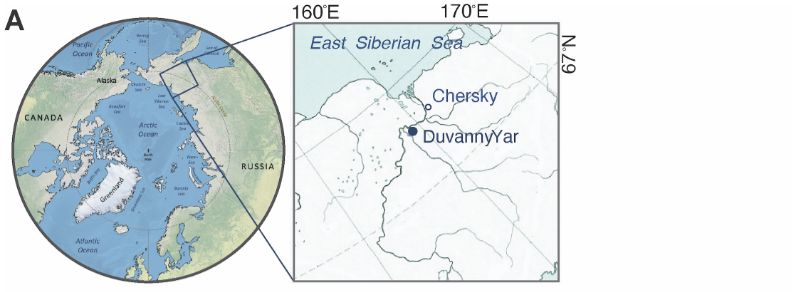The general consensus among us mammals is that if we get very cold, we die. Within the world of nematodes, however, they’d like to differ on that viewpoint. This is demonstrated succinctly after researchers coaxed a batch of these worms back into action after they had been frozen in Siberian permafrost for an estimated 46,000 years. The mechanism underlying this phenomenon is called cryptobiosis, which is essentially a metabolic state that certain lifeforms can enter when environmental conditions become unsuitable.
In the case of nematodes, they hold a number of records, with a group of them having survived the STS-107 Space Shuttle Columbia in 2003 when it broke up during reentry, making it the first known lifeform to have achieved such a feat. During arctic experiments it was found that these roundworms can withstand intracellular freezing even while active depending on its diet.

For these particular permafrost nematodes, they offer us a glimpse at a species of nematodes that hasn’t been around for thousands of years, with phylogenetic analysis indicating them to be related to current species in the Panagrolaimus and Plectus genera, but different enough to receive the new name of Panagrolaimus kolymaensis. In the paper, the researchers describe how they performed experiments on C. elegans nematode larvae to compare its cryptobiosis capabilities and found both to be comparable, although P. kolymaensis shows a stronger ability to protect its cell membranes, which is ultimately key for long-term survival while frozen.
An interesting aspect of nematodes is that some of them are hermaphrodites, meaning that they can reproduce asexually. Combined with an ability to stay dormant across geological timescales, this makes these small worms incredibly hardy survivors that’d give cockroaches a run for their exoskeleton.
(Heading image: Location of the Duvanny Yar outcrop on the Kolyma River, northeastern Siberia, where the nematodes were found. (Credit: Anastasia Shatilovich et al., 2023))
















What could possibly go wrong?
https://en.m.wikipedia.org/wiki/Life_(2017_film)
It went wrong long before that…
https://en.wikipedia.org/wiki/The_Andromeda_Strain_(film)
One of the best movie of that era, watched re-run on TV as kid, could not sleep half a night.10/10
Grreat comments from this. Love H&D.
Always wondered if one day they could figure out how those species (those worms, frogs, etc) survives a long hibernation and find a way to apply it to us human so we could go for deep space exploration.
Human can’t go more than a few days without water. Meanwhile we got worm that can sleep without eating or drinking for thousand years.
No chance, we´ll have ruined our environment and compromised your survival here before we´ll be able to do this. We MUST learn(re-learn) to be able to live in harmony on the long term on this planet before we can even dream of spreading beyond our mud ball.
“Live in harmony” is just airy fairy woo woo nonsense. It doesn’t mean anything but somehow it’ll solve everything. How about make some achievable goals instead?
Seems pretty understandable to me. Live in harmony with each other: don’t wreck the earth over politicians’ wars. Live in harmony with nature: don’t wreck the environment through uncontrolled growth and greed. The achievable goals are pretty easy to derive from that.
What is harmony?
Evolution rewards uncontrolled growth and greed.
No Artenz it does not, it only does so in some edge cases.
Yes it does. Evolution itself is a race to fill all available niches and claim all resources. He who eats, multiplies and survives, and he who doesn’t… well the first guy eventually eats their portion as well. There’s no stable condition where two species compete for the same niche – one eventually replaces the other and takes everything.
Part of evolution is survival, and if you ‘fill a niche’ to the exclusion of everything else (ie: mass extinction of species) then sure, survival in the short term *is* guaranteed, but survival in the long term is *not*.
Don’t confuse evolution of a species with “I’ll do whatever it takes to reach the end of my life, and whatever happens after that – not my problem”.
Go on then, list 5 of those achievable goals.
Excuse me while I type a comprehensive plan for humanity’s future into this comment edit box on hackaday dot com
Or just don’t repeat pseudo-religious nonsense like “learn to live in harmony”. Especially don’t repeat actual religious nonsense like “re-learn to live in harmony”.
By that time we will have settled on Mars and started screwing that planet up too…
@Eric
Given the current state of humanity,I don’t quite know whether that is desirable at all.
Don’t worry. Only the nice people will get the treatment.
…. nice and wealthy people
there are no wealthy nice people
I’m a welthy nice person, even when I shout on people becose my card declined.
Global standards: There are no poor people on hackaday.
Hippies are always the ones who say ‘think globally’. Turnabout etc.
Suck it up rich boy. The poor will eat you (and not in a nice way). Or not, the poor are pretty GD incompetent.
“Ah, I’m still tired, just one more millennium.”
The cyclic nature of Earth’s climate systems is the reason why these worms have gained that function, through natural selection as it has happened to them repeatedly over the last 550 million years.